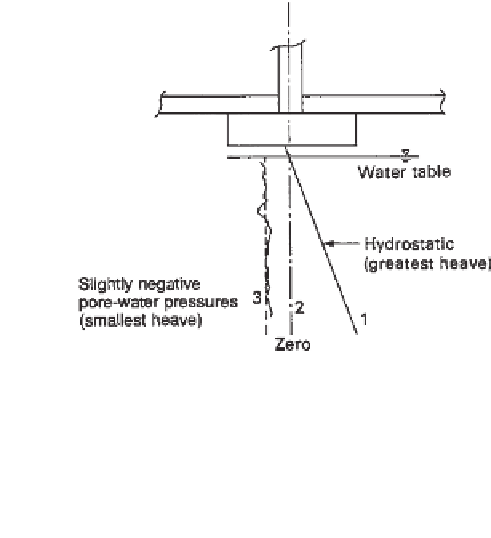Environmental Engineering Reference
In-Depth Information
The above equation defines the initial stress state as
P
0
.
The value of
P
0
is not calculated but is measured as the cor-
rected swelling pressure
P
s
in an oedometer test. The final
stress state
P
f
must account for total stress changes and final
pore-water pressure conditions. The pore-air pressure in the
field remains at atmospheric conditions. The final pore-water
pressure conditions can be predicted or estimated. Therefore,
the final stress state
P
f
can be written as
fluctuation in the groundwater table. The surface flux bound-
ary conditions can vary from one geographic location to
another depending on climatic conditions. Russam and Cole-
man (1961) related the equilibrium suction below asphaltic
pavements to the Thornthwaite moisture index. On many
smaller structures, however, it is often man-made causes
such as leaky water lines, poor drainage, and lawn watering
that control final pore-water pressures in the soil.
There are three typical possibilities for the estimation
of final pore-water pressure conditions, as illustrated in
Fig. 14.37. First, it could be assumed that the water table
will rise to the ground surface, creating a hydrostatic condi-
tion. This assumption results in the calculation of the largest
amount of total heave. Second, it could be assumed that
the pore-water pressure approaches a zero value throughout
its depth. This may appear to be a realistic assumption;
however, it should be noted that it is not an equilibrium
condition. The zero pore-water pressure condition may
provide a reasonable estimate for the final pore-water
pressure state in some situations. Third, it could be assumed
that under long-term equilibrium conditions the pore-water
pressure will remain slightly negative. This assumption
predicts the smallest amount of total heave.
It is also possible to have variations of the above assump-
tions with depth. As well, a limit might be placed on the
depth to which wetting will occur. Any of the above assump-
tions produces a range of predictions of heave that can
be used by the geotechnical engineer to determine reason-
able design estimates for total heave. The above-mentioned
analyses will show that most of the heave occurs in the
uppermost soil layers where the change in matric suction is
largest and the total overburden stresses are the smallest.
P
f
=
σ
v
±
σ
v
−
u
wf
(14.16)
where:
σ
v
=
change in total vertical stress due to the excava-
tion (i.e.,
−
σ
v
) or placement of fill (i.e.,
+
σ
v
)
and
u
wf
=
predicted or estimated final pore-water pressure.
The heave of an individual soil layer can be written in
terms of a change in void ratio:
e
i
h
i
=
h
i
(14.17)
1
+
e
0
i
where:
h
i
=
heave of an individual soil layer,
h
i
=
thickness of a single soil layer into which the total
expansive soil layer has been subdivided,
e
i
=
change in void ratio of the layer under consideration
(i.e.,
e
0
i
−
e
fi
),
e
0
i
=
initial void ratio of the soil layer, and
e
fi
=
final void ratio of the soil layer.
The change in void ratio,
e
i
,
in Eq. 14.17 can be rewrit-
ten in terms of the soil properties and the stress states (i.e.,
Eq. 14.14) to give the following form for the heave of a
single layer:
14.5.4 Zone of Subsoil Wetting
The zone over which wetting will likely take place is a pri-
mary variable that must be assessed or estimated in order to
calculate total heave. The soil immediately below light struc-
tures often increases in water content over time. Irrigation
P
fi
P
0
i
C
s
h
i
=
h
i
log
(14.18)
1
+
e
0
i
where:
P
fi
=
final stress state in the soil layer and
P
0
i
=
initial stress state in the soil layer.
The total heave from the entire expansive soil layer,
H,
is equal to the sum of the heave amounts calculated for each
of the subdivided layers:
h
i
H
=
(14.19)
14.5.3 Estimation of Final Pore-Water Pressures
The final pore-water pressures below a foundation or
pavements can either be predicted through analysis or be
estimated. A prediction must take into consideration the
ground surface moisture flux boundary conditions (i.e., infil-
tration, evaporation, and evapotranspiration) and possible
Figure 14.37
Estimation of final matric suction conditions in soil.











Search WWH ::

Custom Search